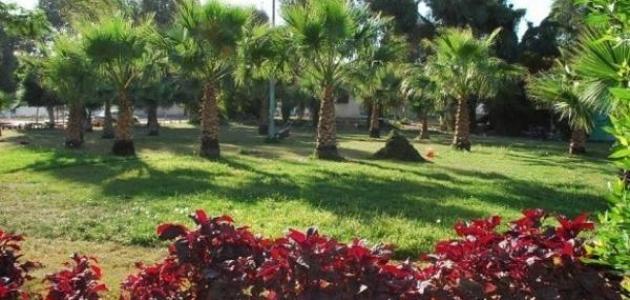The environmental importance of green spaces
The importance of green spaces lies in their many positive effects on the environment, the most prominent of which are the following:
- Reducing the effect of urban heat island phenomenon: This phenomenon indicates that the temperature in cities is higher than in the surrounding rural areas by about 3-4 degrees Celsius. This phenomenon occurs due to human activities concentrated in cities, which in turn generate heat, including: transportation and commercial industrial activities, as this heat does not escape to the atmosphere. Air pollution due to its retention in narrow streets and concrete structures.
- Creating ecosystems in cities: Green spaces contribute to creating new ecosystems within cities, which in turn attract different types of living creatures such as birds and insects.
- Improving quality of life: Green spaces reduce the impact of environmental pollution and limit its damage, by absorbing many gases and pollutants in the air, such as carbon dioxide, which is one of the greenhouse gases that lead to climate change. The processes of renewing and purifying the air also contribute to improving environmental conditions in cities. Thus enhancing individuals' quality of life.
- Reducing the risk of floods: The use of floodplain forests is a natural engineering method that helps control floods. This method also provides natural spaces for recreation and fish farming.
- Finding habitats for living organisms: Green spaces help create natural habitats for various types of living organisms and create wildlife sanctuaries.
Read also:Plant growth
The economic importance of green spaces
The presence of green spaces reflects positively on the economic aspect, as their economic importance is represented in the following:
- Increase labor productivity: The presence of green spaces in the workplace contributes to raising employee morale, which leads to increasing their productivity, as studies indicate that the presence of natural landscapes near office workers contributes to reducing their feelings of anxiety and stress.
- Revitalizing the economy: Multiple studies conducted by Kathleen Wolfe of the University of Washington have shown that shopping malls with green roofs are 9-12% more likely to purchase than in other shopping locations.
- Reducing the costs of solving natural problems: Green spaces contribute to reducing local, regional, and public service costs resulting from pollution and floods.
- Providing investment opportunities: Investing in green spaces is a source of increasing income, by exploiting lands as green spaces, whether by benefiting from the exploited land until other investment opportunities become available for it, or investing in the lands surrounding it, the value of which is higher than others due to their view of the green spaces.
The social importance of green spaces
Green spaces contribute to the stability of society because of their positive effects, the impact of which is evident in the following:
Read also:Structure of plant tissue- Reducing stress and the impact of life pressures: Studies have shown that the presence of green spaces, whether gardens for walking or trees on the road, contributes to reducing quarrels and violence resulting from excessive stress and tension.
- Reducing the rate of committing crimes: Green spaces have an effect in reducing the psychological signs that lead to violence. In addition, green spaces attract many people to them and thus collective surveillance of neighborhoods increases, which reduces the chance of a crime occurring.
- Increased concentration in children: Natural environments help children focus and accomplish their duties, as well as reduce reckless behavior, as children show commitment to instructions and discipline after spending time playing in green places. One American study conducted on 450 children with attention deficit disorder proved that children spending time Close proximity to green spaces resulted in a decrease in disturbance intensity.
The importance of green spaces for health
Green spaces play a major role in improving individuals’ health, as they contribute to the following:
- Improving the performance of mental powers and enhancing cognitive functions.
- Reducing the risk of cardiovascular disease.
- Reducing the spread of type 2 diabetes.
- Positively affecting the health of the pregnant woman and the child.
- Reducing the death rate. A study was published in 2008 in the journal (Lancet), conducted by doctors Richard Mitchell and Frank Popham on 40 million Britons, in which the relationship between the income disparity of individuals, their closeness to nature, and their average life expectancy was studied. The results of the study indicated that the average Life expectancy for individuals living in rural areas was approximately equal between high- and low-income people there.
- Increasing the speed of treatment of diseases, as a study conducted by Roger Ulrich at the Texas Agricultural and Mechanical University showed an increase in the performance of patients who underwent surgery, and whose rooms overlooked green spaces, as the recovery rate increased to 8.5% compared to others who were in regular rooms.
Read also:Report on the environment
Definition of green spaces
Green spaces are defined as public green areas that provide a place for recreation, such as gardens, public parks, natural environments, forests, or green spaces near cities that are used for recreation. This definition is the most widely used in European studies, as stated in the European Atlas of Urban Terminology under Code 14100.
It is worth noting that there are many definitions of green spaces, as there is currently no agreement on a single internationally approved definition. Green spaces may include natural terrain, or green spaces in cities such as street trees, as well as blue spaces, which express water elements of various sizes and locations. As for the spaces The well-known and widespread green greenery in cities is public parks, and some references include children’s playgrounds, schoolyards, roadsides, paths beside rivers, and home gardens.









